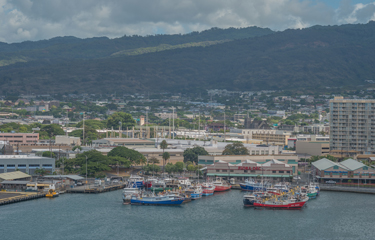Three years after allegations of labor abuses in the Hawaii longline fishing fleet came to light, foreign workers continue to be excluded from the legal protections afforded to U.S. workers, according to a new report from the Georgetown Law Human Rights Institute.
But a special visa allowing workers to temporarily enter the U.S. could improve conditions by allowing workers to more easily access medical care and legal resources.
The report characterized working conditions as “extremely harsh,” but did not determine specific instances of labor abuse. Instead, the report concluded that foreign fishermen in the industry are vulnerable to forced labor.
About 700 foreign fishermen work on U.S. longline vessels in Hawaii, catching tens of millions of pounds of fish every year. The fishermen are confined to the pier area in Honolulu because of an odd visa system that technically denies them entry to the U.S., while allowing them to fish in a U.S. fleet.
The report relied on interviews with 43 fishermen, among other sources, and was produced by 10 Georgetown Law students.
“They cannot go ashore to seek legal counsel, visit doctors regularly (or) buy their own food,” Ashley Binetti Armstrong, a co-instructor for the class and the Dash-Muse teaching fellow at Georgetown, told SeafoodSource. “Their lack of legal status also affects the long and arduous path they must take to arrive in Hawaii, as well as the limitations on how often they can return home to see their families.”
The report followed up on a 2016 story published by the Associated Press that alleged labor abuse in the Hawaii longline fishery. At the time, the Hawaii Seafood Council responded by helping organize a task force, which developed an Employer’s Code of Conduct, a model crew contract and a crew handbook in alignment with guidance from the U.S. Department of Labor.
The three resources were translated into the languages of fishermen and vessel owners, then distributed to labor agents, vessel owners and captains. The model crew contracts were implemented.
“This effort was made to improve the mutual understanding between workers, agents, captains, and vessel owners of their responsibilities in providing decent work in the Hawaii fishing industry,” John Kaneko, program manager for the Hawaii Seafood Council, told SeafoodSource.
In 2016, the Hawaii Seafood Council also commissioned a rapid assessment of the fishery that included interviews with 207 of the 622 workers in the fleet, from 105 of the 141 vessels, Kaneko said. In the assessment, no workers were observed to be on vessels under threat of violence or punishment.
None of the workers reported working on Hawaii vessels against their will, working to repay a loan or service related to employment, not being paid, not being able to return to their home country if desired, or being held responsible for the cost of repatriation at the end of a contract, Kaneko said.
“Our crewmen are legal, fully documented, non-immigrant contract workers. They are not illegal, undocumented immigrants,” Kaneko said. “We need to make a clear distinction between the crimes of human trafficking and forced labor that should be investigated and prosecuted, and workplace grievances regarding working conditions that can be resolved without legal action.”
Until 2004, fishermen were able to fly directly into Honolulu, according to the Georgetown report. Now, workers have to fly to a different port, often in Mexico or American Samoa, where vessel owners pick them up – a huge burden for both vessel owners and workers.
A special visa could change that.
“Crew members need to be able to go home for breaks and to return to work easily,” Katrina Nakamura, a scientist and researcher who works on labor issues in the Hawaii longline fleet and the founder of the Sustainability Incubator, told SeafoodSource. “Policymakers need to move beyond paranoia of foreign workers because it’s inconsistent with the way more American goods are made.”
“Only policymakers can change this, and I hope they will,” Nakamura added.
Despite the challenges the Hawaii longline fleet faces, it’s one of the few places were community members can interact with the people catching the fish they eat. Locals in Hawaii also spend time with the crewmembers to make them feel at home, Nakamura said.
“Most of the seafood [you] eat, and trade today, was made in developing countries by hands and faces you’ll never see, let alone hear about,” Nakamura.







